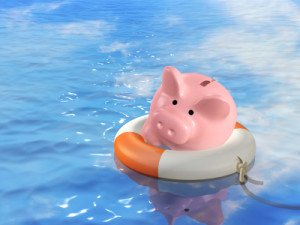 The earthquake that rattled us out of bed Monday morning also served as a reminder: it’s time to check the emergency supplies. And it occurred to me that preparing for emergencies has a lot in common with preparing for retirement. Consider:
The earthquake that rattled us out of bed Monday morning also served as a reminder: it’s time to check the emergency supplies. And it occurred to me that preparing for emergencies has a lot in common with preparing for retirement. Consider:
Most people are woefully unprepared. Not just “under-prepared” but not even being in the same room as prepared. When it comes to retirement savings, one-third of workers have less than $1,000 set aside and 60% have less than $25,000, according to the most recent survey by Employee Benefit Research Institute and Greenwald and Associates.
The solution: Use your imagination. Emergency preparedness experts recommend thinking, in detail, about how you would feed, shelter and tend to the hygiene needs of your family if you were without power, water or a roof for three days. Walking yourself through those days will get you motivated to make your life easier should something happen. A similar exercise can jumpstart your retirement planning: Go to the Social Security estimator, see what you’re scheduled to get at retirement, and imagine trying to live on that.
Many people are overwhelmed. The list of emergency supplies you’re supposed to keep in your home, car and office can be pretty daunting, especially if you’re on a budget. Likewise, the amounts of money people are supposed to save for retirement can seem unrealistically large.
The solution: Start small. Anything you scrape together will help. Getting a kit together can start with some canned goods and a few gallons of water stored in a plastic tote. Getting your retirement together can start with a 1% contribution to a 401(k) or an automatic transfer to an IRA. Build from there, as you can.
You can’t “set it and forget it.” Once you’ve assembled them, disaster supplies have to be regularly checked to see what’s expired or wandered off. (Somebody may have pilfered the batteries in an “emergency” for a game console, for example.) Likewise, once you start saving for retirement, you need to check in to make sure your investments are properly allocated and regularly rebalanced. Changes in your life or your plans can necessitate changes in your retirement savings, as well.
The solution: Put it on your calendar. Schedule checkups at least once a year.
By the way, you can find lists of emergency supplies at the Red Cross and FEMA’s Ready.gov sites. Or check out this great graphic from the LA Times, which shows how you can store what you need in a clean plastic trash can.
If you’re interested, here are some of the supplies we keep around the house (as well as my notes about what I need to replace/get):
Outside in storage bins:
- Water [need more; we have about half of the two gallons per person per day recommended]
- Food (we have canned food + can opener, peanut butter, crackers, energy bars; I need to add more pet food now that we have a cat]
- Cat and dog crates
- Tent, cookstove, fuel
- Shovel, hatchet, crowbar, hacksaw
- Plastic sheeting (to replace windows), duct tape [need to get: staple gun]
- Plastic goggles, hard hats (protection for clearing debris) [need to find: the work gloves that wandered off]
- Gas shut off tool (we had an automatic shutoff installed, but I like to be sure)
- Rope
- Flashlight, lantern, batteries [looks like I moved the portable radio to some other site; now I just have to remember where]
- Emergency toilet (bucket with a snap-on seat, garbage bags and kitty litter), toilet paper, wipes
- Bleach, castille soap, towels
- Mylar blankets & rain ponchos
- Need: Fire extinguisher, hygiene kit [toothbrushes, floss, hairbrush]
Car kit:
- Bottled water
- Energy bars
- First-aid kit
- Sneakers, socks, extra sweaters and coats
- Multi-tool (oooo I love my Leatherman)
- Wipes
- Wind-up/solar-powered flashlight/radio/cell phone charger
- Regular blanket, mylar blankets & rain ponchos
 Many financial planners view reverse mortgages as a last resort—expensive and unwise except for those who have no other options.
Many financial planners view reverse mortgages as a last resort—expensive and unwise except for those who have no other options.
